Guoren Wang
FedBook: A Unified Federated Graph Foundation Codebook with Intra-domain and Inter-domain Knowledge Modeling
Oct 09, 2025Abstract:Foundation models have shown remarkable cross-domain generalization in language and vision, inspiring the development of graph foundation models (GFMs). However, existing GFMs typically assume centralized access to multi-domain graphs, which is often infeasible due to privacy and institutional constraints. Federated Graph Foundation Models (FedGFMs) address this limitation, but their effectiveness fundamentally hinges on constructing a robust global codebook that achieves intra-domain coherence by consolidating mutually reinforcing semantics within each domain, while also maintaining inter-domain diversity by retaining heterogeneous knowledge across domains. To this end, we propose FedBook, a unified federated graph foundation codebook that systematically aggregates clients' local codebooks during server-side federated pre-training. FedBook follows a two-phase process: (1) Intra-domain Collaboration, where low-frequency tokens are refined by referencing more semantically reliable high-frequency tokens across clients to enhance domain-specific coherence; and (2) Inter-domain Integration, where client contributions are weighted by the semantic distinctiveness of their codebooks during the aggregation of the global GFM, thereby preserving cross-domain diversity. Extensive experiments on 8 benchmarks across multiple domains and tasks demonstrate that FedBook consistently outperforms 21 baselines, including isolated supervised learning, FL/FGL, federated adaptations of centralized GFMs, and FedGFM techniques.
Two Sides of the Same Optimization Coin: Model Degradation and Representation Collapse in Graph Foundation Models
Sep 11, 2025Abstract:Graph foundation models, inspired by the success of LLMs, are designed to learn the optimal embedding from multi-domain TAGs for the downstream cross-task generalization capability. During our investigation, graph VQ-MAE stands out among the increasingly diverse landscape of GFM architectures. This is attributed to its ability to jointly encode topology and textual attributes from multiple domains into discrete embedding spaces with clear semantic boundaries. Despite its potential, domain generalization conflicts cause imperceptible pitfalls. In this paper, we instantiate two of them, and they are just like two sides of the same GFM optimization coin - Side 1 Model Degradation: The encoder and codebook fail to capture the diversity of inputs; Side 2 Representation Collapse: The hidden embedding and codebook vector fail to preserve semantic separability due to constraints from narrow representation subspaces. These two pitfalls (sides) collectively impair the decoder and generate the low-quality reconstructed supervision, causing the GFM optimization dilemma during pre-training (coin). Through empirical investigation, we attribute the above challenges to Information Bottleneck and Regularization Deficit. To address them, we propose MoT (Mixture-of-Tinkers) - (1) Information Tinker for Two Pitfalls, which utilizes an edge-wise semantic fusion strategy and a mixture-of-codebooks with domain-aware routing to improve information capacity. (2) Regularization Tinker for Optimization Coin, which utilizes two additional regularizations to further improve gradient supervision in our proposed Information Tinker. Notably, as a flexible architecture, MoT adheres to the scaling laws of GFM, offering a controllable model scale. Compared to SOTA baselines, experiments on 22 datasets across 6 domains demonstrate that MoT achieves significant improvements in supervised, few-shot, and zero-shot scenarios.
Efficient Exact Resistance Distance Computation on Small-Treewidth Graphs: a Labelling Approach
Sep 05, 2025Abstract:Resistance distance computation is a fundamental problem in graph analysis, yet existing random walk-based methods are limited to approximate solutions and suffer from poor efficiency on small-treewidth graphs (e.g., road networks). In contrast, shortest-path distance computation achieves remarkable efficiency on such graphs by leveraging cut properties and tree decompositions. Motivated by this disparity, we first analyze the cut property of resistance distance. While a direct generalization proves impractical due to costly matrix operations, we overcome this limitation by integrating tree decompositions, revealing that the resistance distance $r(s,t)$ depends only on labels along the paths from $s$ and $t$ to the root of the decomposition. This insight enables compact labelling structures. Based on this, we propose \treeindex, a novel index method that constructs a resistance distance labelling of size $O(n \cdot h_{\mathcal{G}})$ in $O(n \cdot h_{\mathcal{G}}^2 \cdot d_{\max})$ time, where $h_{\mathcal{G}}$ (tree height) and $d_{\max}$ (maximum degree) behave as small constants in many real-world small-treewidth graphs (e.g., road networks). Our labelling supports exact single-pair queries in $O(h_{\mathcal{G}})$ time and single-source queries in $O(n \cdot h_{\mathcal{G}})$ time. Extensive experiments show that TreeIndex substantially outperforms state-of-the-art approaches. For instance, on the full USA road network, it constructs a $405$ GB labelling in $7$ hours (single-threaded) and answers exact single-pair queries in $10^{-3}$ seconds and single-source queries in $190$ seconds--the first exact method scalable to such large graphs.
Graph-Based Feature Augmentation for Predictive Tasks on Relational Datasets
Aug 28, 2025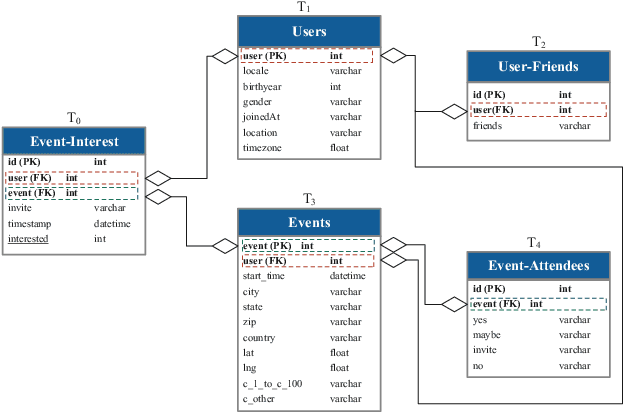
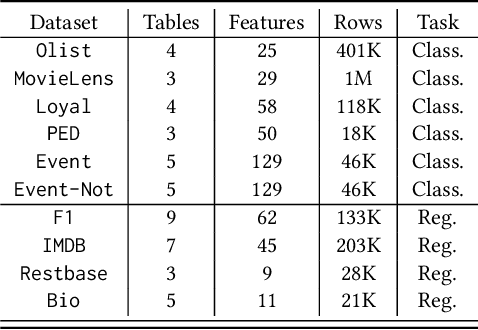
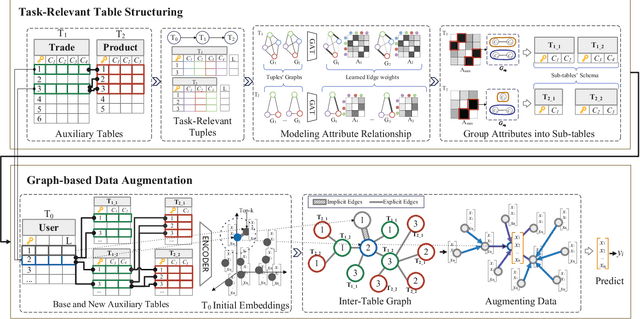

Abstract:Data has become a foundational asset driving innovation across domains such as finance, healthcare, and e-commerce. In these areas, predictive modeling over relational tables is commonly employed, with increasing emphasis on reducing manual effort through automated machine learning (AutoML) techniques. This raises an interesting question: can feature augmentation itself be automated and identify and utilize task-related relational signals? To address this challenge, we propose an end-to-end automated feature augmentation framework, ReCoGNN, which enhances initial datasets using features extracted from multiple relational tables to support predictive tasks. ReCoGNN first captures semantic dependencies within each table by modeling intra-table attribute relationships, enabling it to partition tables into structured, semantically coherent segments. It then constructs a heterogeneous weighted graph that represents inter-row relationships across all segments. Finally, ReCoGNN leverages message-passing graph neural networks to propagate information through the graph, guiding feature selection and augmenting the original dataset. Extensive experiments conducted on ten real-life and synthetic datasets demonstrate that ReCoGNN consistently outperforms existing methods on both classification and regression tasks.
HIAL: A New Paradigm for Hypergraph Active Learning via Influence Maximization
Jul 28, 2025Abstract:In recent years, Hypergraph Neural Networks (HNNs) have demonstrated immense potential in handling complex systems with high-order interactions. However, acquiring large-scale, high-quality labeled data for these models is costly, making Active Learning (AL) a critical technique. Existing Graph Active Learning (GAL) methods, when applied to hypergraphs, often rely on techniques like "clique expansion," which destroys the high-order structural information crucial to a hypergraph's success, thereby leading to suboptimal performance. To address this challenge, we introduce HIAL (Hypergraph Active Learning), a native active learning framework designed specifically for hypergraphs. We innovatively reformulate the Hypergraph Active Learning (HAL) problem as an Influence Maximization task. The core of HIAL is a dual-perspective influence function that, based on our novel "High-Order Interaction-Aware (HOI-Aware)" propagation mechanism, synergistically evaluates a node's feature-space coverage (via Magnitude of Influence, MoI) and its topological influence (via Expected Diffusion Value, EDV). We prove that this objective function is monotone and submodular, thus enabling the use of an efficient greedy algorithm with a formal (1-1/e) approximation guarantee. Extensive experiments on seven public datasets demonstrate that HIAL significantly outperforms state-of-the-art baselines in terms of performance, efficiency, generality, and robustness, establishing an efficient and powerful new paradigm for active learning on hypergraphs.
A Comprehensive Data-centric Overview of Federated Graph Learning
Jul 22, 2025Abstract:In the era of big data applications, Federated Graph Learning (FGL) has emerged as a prominent solution that reconcile the tradeoff between optimizing the collective intelligence between decentralized datasets holders and preserving sensitive information to maximum. Existing FGL surveys have contributed meaningfully but largely focus on integrating Federated Learning (FL) and Graph Machine Learning (GML), resulting in early stage taxonomies that emphasis on methodology and simulated scenarios. Notably, a data centric perspective, which systematically examines FGL methods through the lens of data properties and usage, remains unadapted to reorganize FGL research, yet it is critical to assess how FGL studies manage to tackle data centric constraints to enhance model performances. This survey propose a two-level data centric taxonomy: Data Characteristics, which categorizes studies based on the structural and distributional properties of datasets used in FGL, and Data Utilization, which analyzes the training procedures and techniques employed to overcome key data centric challenges. Each taxonomy level is defined by three orthogonal criteria, each representing a distinct data centric configuration. Beyond taxonomy, this survey examines FGL integration with Pretrained Large Models, showcases realistic applications, and highlights future direction aligned with emerging trends in GML.
When LLMs meet open-world graph learning: a new perspective for unlabeled data uncertainty
May 21, 2025Abstract:Recently, large language models (LLMs) have significantly advanced text-attributed graph (TAG) learning. However, existing methods inadequately handle data uncertainty in open-world scenarios, especially concerning limited labeling and unknown-class nodes. Prior solutions typically rely on isolated semantic or structural approaches for unknown-class rejection, lacking effective annotation pipelines. To address these limitations, we propose Open-world Graph Assistant (OGA), an LLM-based framework that combines adaptive label traceability, which integrates semantics and topology for unknown-class rejection, and a graph label annotator to enable model updates using newly annotated nodes. Comprehensive experiments demonstrate OGA's effectiveness and practicality.
Not All Documents Are What You Need for Extracting Instruction Tuning Data
May 18, 2025Abstract:Instruction tuning improves the performance of large language models (LLMs), but it heavily relies on high-quality training data. Recently, LLMs have been used to synthesize instruction data using seed question-answer (QA) pairs. However, these synthesized instructions often lack diversity and tend to be similar to the input seeds, limiting their applicability in real-world scenarios. To address this, we propose extracting instruction tuning data from web corpora that contain rich and diverse knowledge. A naive solution is to retrieve domain-specific documents and extract all QA pairs from them, but this faces two key challenges: (1) extracting all QA pairs using LLMs is prohibitively expensive, and (2) many extracted QA pairs may be irrelevant to the downstream tasks, potentially degrading model performance. To tackle these issues, we introduce EQUAL, an effective and scalable data extraction framework that iteratively alternates between document selection and high-quality QA pair extraction to enhance instruction tuning. EQUAL first clusters the document corpus based on embeddings derived from contrastive learning, then uses a multi-armed bandit strategy to efficiently identify clusters that are likely to contain valuable QA pairs. This iterative approach significantly reduces computational cost while boosting model performance. Experiments on AutoMathText and StackOverflow across four downstream tasks show that EQUAL reduces computational costs by 5-10x and improves accuracy by 2.5 percent on LLaMA-3.1-8B and Mistral-7B
Rethinking Graph Out-Of-Distribution Generalization: A Learnable Random Walk Perspective
May 09, 2025Abstract:Out-Of-Distribution (OOD) generalization has gained increasing attentions for machine learning on graphs, as graph neural networks (GNNs) often exhibit performance degradation under distribution shifts. Existing graph OOD methods tend to follow the basic ideas of invariant risk minimization and structural causal models, interpreting the invariant knowledge across datasets under various distribution shifts as graph topology or graph spectrum. However, these interpretations may be inconsistent with real-world scenarios, as neither invariant topology nor spectrum is assured. In this paper, we advocate the learnable random walk (LRW) perspective as the instantiation of invariant knowledge, and propose LRW-OOD to realize graph OOD generalization learning. Instead of employing fixed probability transition matrix (i.e., degree-normalized adjacency matrix), we parameterize the transition matrix with an LRW-sampler and a path encoder. Furthermore, we propose the kernel density estimation (KDE)-based mutual information (MI) loss to generate random walk sequences that adhere to OOD principles. Extensive experiment demonstrates that our model can effectively enhance graph OOD generalization under various types of distribution shifts and yield a significant accuracy improvement of 3.87% over state-of-the-art graph OOD generalization baselines.
Toward Data-centric Directed Graph Learning: An Entropy-driven Approach
May 02, 2025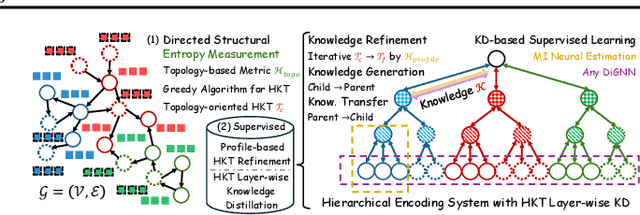

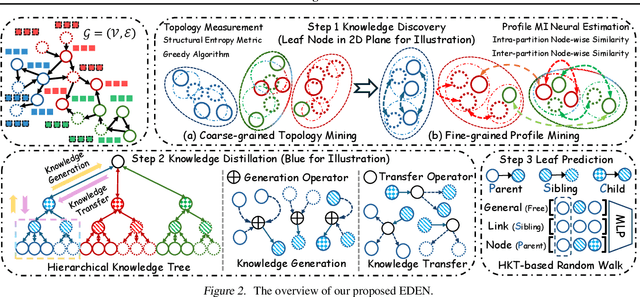

Abstract:The directed graph (digraph), as a generalization of undirected graphs, exhibits superior representation capability in modeling complex topology systems and has garnered considerable attention in recent years. Despite the notable efforts made by existing DiGraph Neural Networks (DiGNNs) to leverage directed edges, they still fail to comprehensively delve into the abundant data knowledge concealed in the digraphs. This data-level limitation results in model-level sub-optimal predictive performance and underscores the necessity of further exploring the potential correlations between the directed edges (topology) and node profiles (feature and labels) from a data-centric perspective, thereby empowering model-centric neural networks with stronger encoding capabilities. In this paper, we propose \textbf{E}ntropy-driven \textbf{D}igraph knowl\textbf{E}dge distillatio\textbf{N} (EDEN), which can serve as a data-centric digraph learning paradigm or a model-agnostic hot-and-plug data-centric Knowledge Distillation (KD) module. The core idea is to achieve data-centric ML, guided by our proposed hierarchical encoding theory for structured data. Specifically, EDEN first utilizes directed structural measurements from a topology perspective to construct a coarse-grained Hierarchical Knowledge Tree (HKT). Subsequently, EDEN quantifies the mutual information of node profiles to refine knowledge flow in the HKT, enabling data-centric KD supervision within model training. As a general framework, EDEN can also naturally extend to undirected scenarios and demonstrate satisfactory performance. In our experiments, EDEN has been widely evaluated on 14 (di)graph datasets (homophily and heterophily) and across 4 downstream tasks. The results demonstrate that EDEN attains SOTA performance and exhibits strong improvement for prevalent (Di)GNNs.
 Add to Chrome
Add to Chrome Add to Firefox
Add to Firefox Add to Edge
Add to Edge